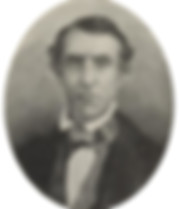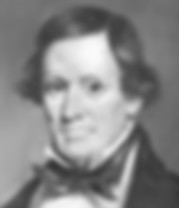
Walk Through
HISTORY
HISTORY
Cypress Grove Cemetery

Cypress Grove Cemetery
Cypress Grove Cemetery became the first cemetery built to honor New Orleans volunteer firemen and their families with the help of New Orleans philanthropist Stephen Henderson in 1838. Henderson’s estate left property to the Firemen’s Charitable & Benevolent Association. The charitable association sold this property to fund the purchase of the cemetery site at the end of Canal Street and the former banks of Bayou Metairie.
The Firemen’s Charitable & Benevolent Association established Cypress Grove Cemetery in 1840. Architect Frederick Wilkinson patterned the grand entrance pylons and lodges after Egyptian ceremonial architecture. The motto, “Here to their bosom mother earth, take back in peace what thou has given, and, all that is of heavenly birth, God in peace recall to heaven,” crowned this imposing entrance.
Shortly after opening the cemetery, the remains of volunteer firemen entombed elsewhere were moved to Cypress Grove. Volunteer fire companies built elaborate multi-vault tombs to enshrine their fallen members. The vaults of Perseverance Fire Co. No. 13 are erected at the entrance of Cypress Grove. This tomb was designed by architect John Barrett in 1840. The twin tombs of the Philadelphia Fire Engine Co. No. 14 and that of the Eagle Co. No. 7 were erected in the 1840s.

Cypress Grove Tombs
A Home for New Orleans' Heroes
In time, other societies joined the volunteer firemen in building impressive monuments for their members at Cypress Grove. Leading architects and craftsmen were called upon to design and build tombs commemorating the lives of New Orleans’ most prominent citizens. Crafted in marble, granite and cast iron, tombs at Cypress Grove are among the nation’s leading examples of memorial architecture.
Notable Residents

James H. Caldwell
Theatrical Impresario and Entrepreneur
James Caldwell was a theatrical impresario who built the first English-speaking theater in New Orleans, The St. Charles. The ornate five tier and 4,100 seat theater was considered the finest theatrical facility in America. Caldwell sent to England for a gas machine to light his chandeliers. Eventually, Caldwell would not only light his stage but all New Orleans. His New Orleans Gas Light Company illuminated streets and houses, making New Orleans the fourth American city to have gas – right behind Baltimore, New York and Boston. The most consequential entrepreneur of his era, Caldwell went to his grave in Cypress Grove known as New Orleans’ Father of Light.

Irad Ferry
Leading Businessman & Mississippi Co. No. 2 Volunteer Fireman
Irad Ferry served as treasurer of the Firemen’s Charitable & Benevolent Association. He died fighting a fire on Camp Street on New Year’s Day 1837. He was the first of many Association members and among the many brave volunteer and professional firemen to lose his life in the line of duty. His remains were moved to the new cemetery during its dedication ceremony in 1841. The Irad Ferry monument in Cypress Grove symbolizes a life cut short with a broken Doric column planted atop the classical sarcophagus. The stone coffin depicts a 19th Century fire engine in crisp relief. It was designed by the famed architect Jacques de Pouilly, who modeled the Ferry memorial after a monument in the Pere Lachaise Cemetery in Paris.

John T. Monroe
Mayor of New Orleans – 1860-1862 and 1866-1867
A native of Virginia and blood relative of President James Monroe, Mayor Monroe came to New Orleans before his 21st birthday with only three dollars in his pocket. Working as a laborer on the levee, he learned the business of stevedoring. He became a labor leader and drifted into politics. In 1858, he was elected to the Board of Assistant Aldermen and was placed on the important committee of streets and landings. Two years later, Monroe was promoted mayor. His administration was noted for moving the streetcar tracks from the sides of Canal Street to the neutral ground. He also connected the city to the Carrollton suburb with the Carrollton Railroad. Shortly after the outbreak of the Civil War, the city fell into the hands of Federal authorities and General Butler ordered Mayor Monroe to be sent to prison. After the war, Monroe was reelected Mayor in 1866. Signs of the city’s recovery from the war were noted in Monroe’s second term with the operation of the first streetcars on St. Charles Avenue and Carondelet Street and the opening of the Tchoupitoulas line.

John R. Conway
Mayor of New Orleans – 1868-1870
Mayor Conway was a successful wholesale grocer during the Civil War. After the war, he became the first chairman of the reorganized Orleans Parish Democratic Committee. His election as mayor marked the end of military control over local government. During his administration, the city took shipment of American sculptor Hiram Powers’s statue of Benjamin Franklin.

Charles L. Leeds
Mayor of New Orleans – 1874-1876
Mayor Leeds’ administration succeeded in passing an act in the state legislature empowering the city of New Orleans to take over drainage projects. During his tenure, a drainage canal on Nashville Avenue was completed to drain the low area between St. Charles Avenue and the Mississippi River. Leeds also extended the street railways, extending the line running out to the Lake Pontchartrain Summer Resort. Mayor Leeds died in 1898 at the age of 75 and became the first Mayor of New Orleans interred in Cypress Grove.

Maunsel White
Veteran of the Battle of New Orleans and Notable Merchant
Maunsel White was a prominent businessman in antebellum Louisiana, better known among epicures for his creation, Maunsel White Peppersauce. White was among the first in the nation to market a sauce of Tabasco chiles. White’s secret recipe of mashed and strained chiles mixed with vinegar and salt cultivated appetites around the world. Maunsel White is entombed in a fine marble memorial designed in the Greek Revival style by architect Jacques de Pouilly.
